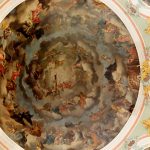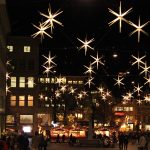As the UNESCO comments:
The Cathedral of St James in Šibenik (1431-1535), on the Dalmatian coast, bears witness to the considerable exchanges in the field of monumental arts between Northern Italy, Dalmatia and Tuscany in the 15th and 16th centuries. The three architects who succeeded one another in the construction of the Cathedral – Francesco di Giacomo, Georgius Mathei Dalmaticus and Niccolò di Giovanni Fiorentino – developed a structure built entirely from stone and using unique construction techniques for the vaulting and the dome of the Cathedral. The form and the decorative elements of the Cathedral, such as a remarkable frieze decorated with 71 sculptured faces of men, women, and children, also illustrate the successful fusion of Gothic and Renaissance art.
西贝尼克的圣詹姆斯大教堂(1431年至1535年)位于达尔马提亚海岸(Dalmatian coast),见证了15和16世纪意大利北部、达尔马提亚与托斯卡纳之间建筑艺术领域的大规模交流。弗兰切斯科迪·贾科莫(Francesco di Giacomo)、佐治鸠斯·马赛·达尔马提库斯(Georgius Mathei Dalmaticus)和尼科络·帝·乔万尼·菲奥伦提诺(Niccolò di Giovanni Fiorentino)三位建筑师相继负责大教堂的建设工作。他们发明了一种结构,完全由岩石构成,并采用了独特的建筑技巧修建大教堂的拱顶和圆顶。大教堂的形式和装饰要素,例如由71个形态各异的男人、女人、孩子脸装饰的教堂中眉,展现了哥特艺术与文艺复兴艺术的成功融合。


To conclude, influenced by the monumental arts of Northern Italy, Dalmatia and Tuscany in the 15th and 16th century, the Cathedral of St. James in Šibenik is a magnificent example of the blend and mixture of Gothic and Renaissance styles. This cathedral has witnessed the transition of church architecture from Gothic style to early renaissance style and to pure Tuscany renaissance. All the influences, mixture, blending and transition provided solutions and contributed to the successful construction of the cathedral vaults and dome.

1. The history and cultural value
In order to understand its cultural value, it’s important to understand the cathedral’s construction history. The history of the cathedral what I will introduce to you below is based on the information provided by the brochure, which you can obtain at the entrance of the cathedral when you enter and buy the entry ticket.
Today’s Cathedral of St. James was built on the old Romanesque St. James’ church and the whole construction took 105 years (1431-1536). Like many other historic buildings, the cathedral has gone through difficult times as well, for example the Turkish threat and the plague epidemic. However, thanks to three major master masons, the cathedral has achieved its today’s glory. Three master masons, namely Bonino da Milano, Juraj Dalmatinac and his successor (also the disciple of Donatello) Nikola Firentinac devoted their knowledge, intelligence and lives to constructing and decorating this cathedral and making it a pearl of human beings’ cultural heritage.
Bonino da Milano constructed the northern and western walls as well as the portals in late Gothic style and Juraj Dalmatinac (1441-1473)brought the first touch of early Renaissance art into Dalmatia by adding a dome and building the lower parts of the shrine, that is to say the baptistery and vestry. It was him who introduced the principle of the unity of stone construction. What is especially notable are the sculptures that he spent his life carving till his death. They are located in the baptistery and along the exterior of the cathedral, that is to say the frieze decorated with 71 sculptured faces of men, women, and children. The successor of Juraj Dalmatinac (also the disciple of Donatello), Nikola Firentinac introduced pure Tuscany Renaissance style to this cathedral by decorating the shrine and the cathedral, presenting to us nowadays the elegant stone dome and vaults. Another unique feature of this cathedral is that the exterior looks like a shell covering the interior so it’s easy to guess what the inside is like once you see the outside of it. This unity also contributed to the worldwide reputation of this cathedral.

2. Practical info about visiting this cathedral
- Winter Periods: every day from 8.30 am- 12 pm and from 4.00 pm – 8.00 pm
- Summer Periods: throughout the day from 8.30 am – 8.00 pm.
- Mass: every day at 9.30 am, 11 am and 6 pm
The most important thing about visiting the cathedral is to obtain a brochure from the ticket office when you buy your entry tickets. There is no particular office for selling tickets but a desk with an employee located at the portal. You won’t miss it because if you wanna visit the cathedral you have to pass it and buy the tickets.
The brochure which provides information and description of the cathedral is available in various languages (at least I obtained the English, Chinese and Russian version so I assume its available in many other languages). Don’t be disappointed if you see the sign saying no pictures in this cathedral because I asked the employee especially and she told me it is allowed to take photos but without flash.
For religious reason, please don’t wear tanks or sleeveless t-shirts or shorts or flip-flops into the cathedral. If you didn’t notice or couldn’t change due to some reason, it is possible to take a scarf at the entrance to cover yourself.
I would suggest that the general visiting time in and outside the cathedral is around 1 hour and of course, if you can fascinated by its culture, history and art style, you can stay as long as you want.
3. What to see outside the cathedral


One of the most notable artworks of this cathedral is the western main portal and in order to enter the cathedral, I believe you won’t miss it. This is the work by the first master mason Bonino de Milano, with statues of Jesus Christ and his 12 apostles.





On the tops of the roof gables are three sculptures made by the third master mason Nikola Firentinac. They are St. Michael fights Satan, St. James and St. Marcus.
Once you get the brochure, don’t forget to check out letter C, Two Renaissance puttis, under whose feet is the only remaining signature of master Juraj Dalmatinac.
If you have more time wandering around, you can also check out the northern portal “Lion Gate”, the Vestry and the Episcopal Palace and read about them in the brochure.
4. What to see inside the cathedral
4.1 Baptistery (number 12)
There are many more things to see and to read about inside the cathedral so it’s definitely worth the ticket. The most notable site inside this cathedral is probably the baptistery designed and created by the second master mason Juraj Dalmatinac (1441-1473). It is regarded as the pearl of the Croatian sacral art and represents the first Renaissance sculptural work in Croatia. It is located under the southern apse and is at street level.


As written in the brochure by Meri Zornija,
By means of the masterful usage of the ground inclination, he built it under the southern apse and furnished it in the form of a quadrilobe. While building, he applied the original assembly method that allowed the same slabs to serve as the vault of the baptistery, as well as the floor of the southern apse. Using the same method, Nikola Firentinac built the dome later.
The entire upper part of the baptistery is covered by a lace-like Juraj’s sculptures, which combine the decorative late Gothic style with the new Renaissance forms. His statues and reliefs of angels, together with those placed on the northern facade, which hold a scroll with the consecration inscription, are full of childish vividness and ease and represent the first Renaissance sculptural work in Croatia.
If you are interested in the niches, vaults, the Gothic traceries, the baldachins of the baptistery and wanna know more about them please don’t hesitate to contact me. I can either send you a copy of the brochure or write more about the baptistery to you.
4.2 Other sites of interest
In general it is rather easy and convenient to have a tour inside the church by yourself once you have obtained the brochure. All you need to do is to follow the numbers from 1-16 and you will see basically everything.
Now I’ll show you some of the attractions of interest that you can expect in the cathedral according to the numbers from 1-16.
1. The Sarcophagus of the bishop of Šibenik Ivan II Lucije Štsfilić, who consecrated the cathedral in 1955.

3. Wooden Renaissance alter (of the three kings) with a painting from the 16th century.

4. Baroque altar (Lady of Camel) with a wooden statue of the Mother of God.

5. Baroque altar (of the holy cross) with the artist’s signature at the bottom of the cross.

6 & 7. Burial chamber of the bishop of Šibenik Luka Spingaroli (1573-1589) and Ivan Dominik Callegari (1676-1722).


8. Canonical stone benches, balustrades and ambones, a work by Nikola Firentinac from around 1500.

9. The bishop’s throne with a stone baldachin.

10. Main altar of (The Sighing Lady) from 1640 with the miraculous painting of the Mother of God from the 15th century.


13. Baroque alter of St. Fabian and St. Sebastian with a renaissance painting by the disciple of Titian.

14. Alter of St. Christopher and (of the Lady of Health), with a baroque wooden saint’s statue and a painting of the Lady of Health from the 15th century, who once protected the main fortress in Šibenik, the fortress of St. Michael. (To be honest, I didn’t find the painting…)

15. Neobaroque altar from 1876.

16. Funerary monument of the bishop of Šibenik Juraj Šižgorić, who made great contribution to the construction of the cathedral. A work by the master mason Juraj Dalmatinac.
Whether you are fascinated by religion, art (Baroque or Renaissance), culture or history, I can assure you that in the Cathedral of St. James, there’s always a lot to listen to and a lot to learn.




[…] history, cultural value and many other aspects. For more information about this cathedral, please click here to visit my the other post “St. James Cathedral in Šibenik – Witness to the exchanges in […]
[…] James Cathedral in Šibenik – Witness to the exchanges in monumental arts” please click here for more […]